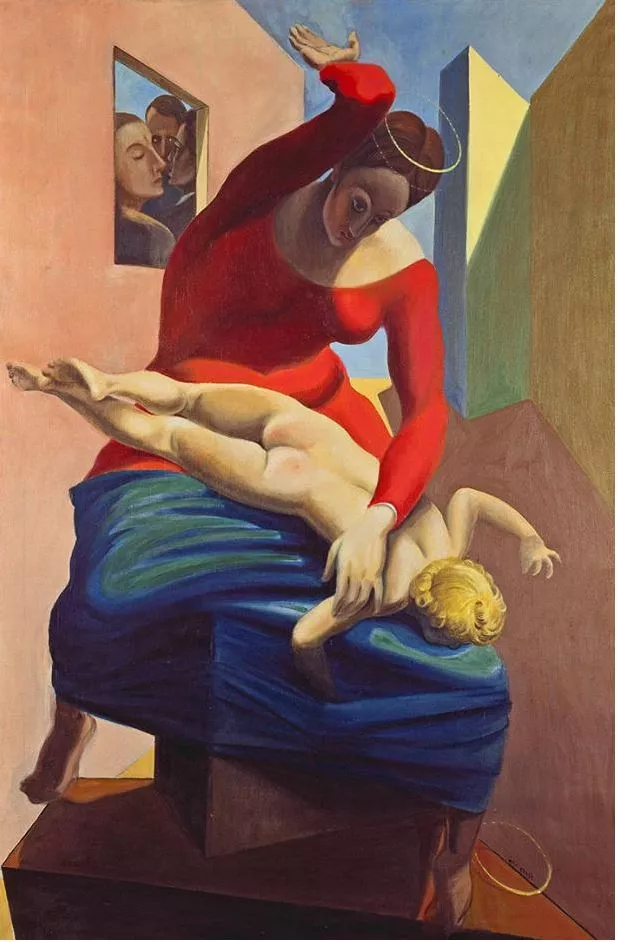Max Ernst: “The Blessed Virgin Chastising The Christ Child in front of Three Witnesses: Andre Breton, Paul Eluard and The Painter”, 1926. Museum Ludwig, Cologne, Germany.
About this Artwork
Why is the Holy Virgin so determine to punish her son? How strained and masklike her face has become! It has lost all the feminine and motherly softness, all the reverie towards the godly nature of child Christ. It is, as though Mary was trying to overcome her natural and pious compassion. Whom does she try to imitate?
An extremely symbolic space with two walls, on the left and on the right, is opened to the heavens. The right wall is, as if, separating god-father’s kingdom of sunny Creation. The left wall is enclosing the human world. And the area of Mary and the child Christ separates the two and mediates between them. It is the area where godly emanation is represented by the sharp triangle of light from above pointed at the godly child. Behind the wall signifying the human world, we see our three witnesses of the truth of the semi-godly and semi-human realm where we see the sadistic cruelty towards Christ as a human god, towards the very human aspect of godliness. On the buttocks and thighs of the child we see redness from the blows inflicted by the mother’s hand (Ernst suggests here, it seems, that the cruelty towards Christ is part of Mary’s destiny). The god-child’s halo ring has fallen to the ground. The position of the child’s body in relation to mother’s “blasphemously” suggests that sadistic libido on part of the mother is part of the situation when beating of the child has perverted sexual connotations which is often the case with physical abuse of children. The parent who has lost his/her temper or follows the proverb that sparing the rod means spoiling the child, is, indeed, as if, trying to break the child’s “stubborn desire” “to be capricious and spoilt” (“to be worshipped”), because parents believe that the sooner a child will learn the lesson the better it will be for him. It is, as though, the child who doesn’t know yet the ordeals and disappointments of adult life, all the terrors and humiliations adults have to go through, and “claims” “to be super-human in comparison with his parents”, has to go through tough pedagogical lessons to be returned to real – human condition. It is possible that in a situation of child Christ it is the mother who feels the necessity to “teach her son” the human – humiliated destiny.
About Max Ernst
Max Ernst(1891–1976) was born near Cologne. While studying at the University of Bonn he became fascinated with the art of mental patients, and through an early friendship with Hans Arp, joined the Dada movement. In 1921 he befriended André Breton, moving to Paris and cofounding Surrealism. Ernst was a pivotal figure in the history of twentieth-century art. A leader of the Dada movement in Germany, he later joined the circle of writers and artists gathered in Paris around André Breton, the unofficial founder of the Surrealist movement. With the Nazi invasion of France in 1939, Ernst fled to America with the assistance of Peggy Guggenheim, only returning to France in 1953 with his third wife, Dorothea Tanning. He died in Paris in 1976.
Painter, sculptor, graphic artist and poet Max Ernst was one of the most versatile artists of the modern era. Starting out as a Dadaist in Cologne, Ernst soon became, in Paris, a pioneer not only of Surrealism but also of such techniques as collage (he invented the collage novel), frottage and grattage. Even later, as a perpetual innovator of figures, forms and techniques, Ernst was continually reorienting and revitalizing his art. In the process he created a huge body of work, whose abiding motif was the bird: an alter-ego he named Loplop. Ernst’s ingenuity and inventiveness in handling dream imagery, the sudden breaks that mark the numerous phases of his work and his constant exploration of techniques all conspire to confound summation of his oeuvre.
